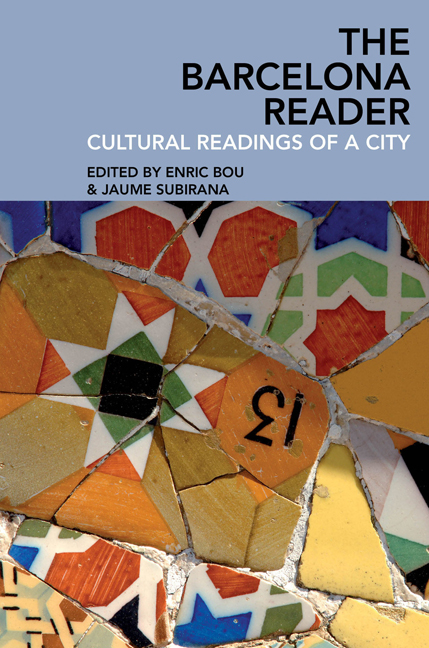Book contents
- Frontmatter
- Contents
- List of illustrations
- Notes on contributors
- Introduction: Barcelona: Cultural readings of a city
- I City, history, and territory
- II City and society
- III Art, architecture, and the city
- 10 Picasso among his fellows at 4 Gats: Beyond Modernisme?
- 11 Gaudí: Poet of stone, artistic hedgehog
- 12 El Poble Espanyol / El Pueblo Español (1929)
- IV The Olympics and the city
- V Literature, cinema, and the city
12 - El Poble Espanyol / El Pueblo Español (1929)
from III - Art, architecture, and the city
- Frontmatter
- Contents
- List of illustrations
- Notes on contributors
- Introduction: Barcelona: Cultural readings of a city
- I City, history, and territory
- II City and society
- III Art, architecture, and the city
- 10 Picasso among his fellows at 4 Gats: Beyond Modernisme?
- 11 Gaudí: Poet of stone, artistic hedgehog
- 12 El Poble Espanyol / El Pueblo Español (1929)
- IV The Olympics and the city
- V Literature, cinema, and the city
Summary
Expositions are arsenals where hardworking people build up their defensive arms…
Seville has been Spain's mirror in Hispanic-America, and Barcelona the reflection of our European spirit.
España en sus exposiciones: Barcelona–Sevilla 1929–1930 (1931)
In 1929 General Miguel Primo de Rivera, King Alfonso XIII, and Queen Victoria Eugenia opened two expositions in Spain: the Ibero-American Exposition in Seville and the International Exposition in Barcelona. The government promoted the expositions as triumphant demonstrations of Spain's place in the world community and Spain's entrance into the twentieth century. At the same time, the expositions were meant to bear witness to the nation's historical (and political) connections to both Latin America and Europe. In the case of the Barcelona Exposition, the dictatorship's dual goals of promoting modernity and tradition were mediated in part by Catalonia's own ambitions and position in relation to the rest of Spain and Europe. Barcelona, the capital city of Catalonia, had been the site of the 1888 International Exposition and was Spain's leading industrial port. The publicity for the Barcelona Exposition portrayed the city as the centre of a revitalized, unified, and technologically advanced modernism, as well as a postwar haven of peace and prosperity for the European nations that had suffered extreme losses during World War I. Barcelona was offered to the public as a dreamscape.
One of a series of widely published advertisements asked readers whether the exposition was ‘Dream or Reality?’ Once the exposition had been built, visitors were encouraged to view the monumental spectacle as a dream transformed into reality. A poster designed by Francesc d'Assís Galí and featured on the cover of the popular Catalan magazine D'Ací i d'Allà gave an image to these national aspirations by portraying Barcelona allegorically as a classically robed woman gracefully rising above the steel tubular forms of industry with a white dove of peace in her hand (Figure 12.1).
At the exposition, Carles Buïgas's syncopated illuminated fountains and projected light beams turned the exposition grounds into a spectacular fantasy of sight, sound, and movement that put technological ingenuity and entertainment on conspicuous display.
Despite these celebratory depictions of Spanish modernity, the national advances that the government claimed were evidence of its success were tempered by economic and political crises.
- Type
- Chapter
- Information
- The Barcelona ReaderCultural Readings of a City, pp. 295 - 320Publisher: Liverpool University PressPrint publication year: 2017

